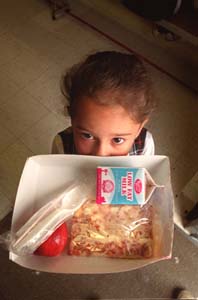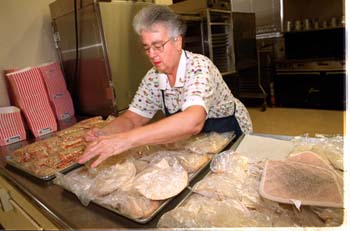![[Metroactive Features]](http://metroactive.com/features/gifs/feat468.gif)
[ Features Index | San Jose | Metroactive Central | Archives ]
Tray Chic: Because many school cafeterias such as Washington Elementary, above, have their students' food prepared off-site, public health inspectors feel they don't need to visit as often.
Lunch Crunch
Because of shrinking funds and loopholes in the law, public health inspectors are treating school cafeterias as a low priority
By Will Harper
LUNCHTIME IS almost over at San Jose's Delos Bagby Elementary School and Brittnay, a sassy fifth-grader with straight blonde hair held in place by a blue bandeaux, is polishing off a taco pocket and getting ready to return to Ms. Warrick's class.
Brittnay says she always eats the cafeteria food now, not like in the third grade when she always brought lunch.
"The food in the cafeteria is better," she opines. "My mom used to always pack me a stupid bologna sandwich all the time."
Tomorrow the cafeteria serves her favorite dish: pizza from Papa John's.
About 250 of Bagby's 600 students shuttle through here every day to eat the cafeteria lunch, which regularly costs $2, but only 40 cents for kids getting financial assistance from the federal government.
Being the only person at the table over 6 feet tall, I stick out like an NBA forward at a midget convention.
I'm not the only unfamiliar presence in the cafeteria today.
Outside, Santa Clara County environmental health specialist Michael Powell scribbles down his final observations of the cafeteria conditions. It's been 16 months since a county health inspector last visited Bagby, a far cry from the Department of Environmental Health's goal of inspecting public school cafeterias every six months.
Powell has spent the past 30 to 40 minutes snooping around the kitchen.
For the most part, Powell is impressed by Bagby's cafeteria. The floors are almost spotless. The servers have washed their hands and wear rubber gloves. After being heated, the corndogs, taco pockets and nacho cheese--which were all actually prepared off-site at a nearby middle school and delivered to Bagby--register temperatures above 140 degrees, the minimum that health officials consider safe for serving.
But Powell, who started working for Santa Clara County's inspection program in March, does have a few concerns. He returns to the kitchen and finds Tom Trapani, an operations manager for Sodexho Marriott School Services, the company that oversees food operations for the Cambrian School District.
"You're doing a great job here," Powell begins, making his way to the inevitable "but."
"I'm going to read my report," Powell continues, "and I'd like you to read along."
Most of his concerns are relatively minor. Powell instructs Trapani to get new, accurate thermometers for the walk-in refrigerator, replace a shelf unit and the aging exhaust system. Some of the cabinets "contained food and foreign debris," Powell reads from his notes. "Please clean this area to prevent insect or vermin intrusion." Parenthetically, Powell noted in his report, "No indication of such [intrusion] during this inspection."
While Powell is finishing his lecture, I notice something scurrying on the floor near Trapani's foot. It's a cockroach.
Child's Play: When money's short, cut services to the nonvoters first.
Hint Droppings
IN FAIRNESS, inspectors can't be expected to catch every little thing during a 60-to-90-minute site visit. But lag-time between those visits in Santa Clara County often exceeds one year, raising the nasty question: Are cockroaches the only things escaping detection?
It took a year for a county health inspector to make it out to Mt. Pleasant High School in San Jose, but when he did--well, let's hope our favorite niece or nephew didn't buy anything at the snack bar in late 1998 and early 1999.
"Heavy rodent infestation," Judy McDonald, inspector, noted in her Nov. 6, 1998, official report of Mt. Pleasant High School. "Many fresh droppings seen behind equipment."
Eighteen days later, McDonald returned--only to find more signs of snack-eating rodents. "Snack bar must remain rodent-proof," McDonald warned, "or it will not be allowed to remain open."
Apparently, the school staff didn't heed her warning. On her Jan. 5, 1999, follow-up visit, McDonald still found a "large amount of rodent droppings around the snack bar." For good measure, she warned school staff of possible legal action.
Finally, two weeks later--and more than two months after the initial inspection--the school eliminated its rat problem. Or, at least, there were no signs of infestation this time.
Health officials were apparently impressed enough that they didn't revisit Mt. Pleasant High School for another 14 months--near the end of the following school year on May 31, 2000.
Major lag-time between school inspections is not uncommon in Santa Clara County. Based on data provided by the Department of Environmental Health, the county averaged about 1.36 inspections per public school in 1999.
More than twenty schools have been inspected only once since the beginning of 1998 through Sept. 15 of this year, according to county records.
Milpitas High School, which serves food to approximately 1,200 students a day, is one of those schools. Since the beginning of 1998, health officials have only visited Milpitas High School's food-service area once--Oct. 13, 1999. The inspector deemed the high school cafeteria to be in good shape with no significant health code violations.
Eighteen months earlier, however, after receiving an anonymous complaint, inspector Viet Dao found cockroaches had invaded the school's homemaking class in Room J13. Files in the cabinet next to the instructor's cook station "were literally sprinkled with cockroach droppings," Dao noted at the time.
But even when inspectors do find significant health violations during a routine inspection, they occasionally follow up at glacial speed.
Take the case of Benjamin Cory Elementary. During a Nov. 22, 1999, visit, the first one at the school in a year, a health inspector impounded 33 lunch trays worth of taquitos being stored at an unsafe temperature in an out-of-order refrigerator. The inspector gave the school an overall mark of "fair." Of the five marks it could have received, only "poor" is worse.
The county hasn't been out to Benjamin Cory since, records indicate.
Linda Keahey, director of the consumer protection division of the Department of Environmental Health, blames the inconsistent inspection rates on a nagging staff shortage in areas like Milpitas. Keahey says the department currently has only 37 inspectors on staff to monitor the county's 11,000 food service establishments.
But an overloaded staff isn't the only reason inspectors make it out to school cafeterias inconsistently.
Santa Clara County's Department of Environmental Health and local health agencies throughout the state (see related story) make inspecting schools a lower priority to begin with.
Photograph by George Sakkestad
Standards Deviation
THE DEPARTMENT OF Environmental Health here targets small restaurants--defined as five or fewer employees--at least three times a year for routine checkups. For midsize restaurants with six to 24 employees, the county has a goal of conducting at least four routine inspections each year.
In contrast, the county says it tries to inspect public school cafeterias twice a year--regardless of the size of the operation or whether food is prepared on-site or off-site or the school gets a lousy inspection grade.
Linda Keahey, the director of the department's consumer protection division, maintains there are good reasons for the disparity.
"They [school cafeterias] have a limited type of food service," she says, "and a limited operating time. They usually only serve one meal and they serve it quickly."
Restaurants pose greater health risks than cafeterias because they operate longer hours and serve a greater variety of dishes.
But while adults can pick and choose where they want to eat, kids aren't so lucky. Thousands of low-income students in the national school-lunch program have to eat cafeteria food whether they like it or not.
Still, Keahey says the differing inspection rate standards are justified. She adds that most schools these days often have their food prepared off-site by private contractors like Sodexho Marriott. Thus, school cafeteria workers are primarily dealing with pre-packaged goods requiring limited handling, which further reduces health risks, she says.
"It's a very regimented food service," she explains. "In our experience, we haven't had any major issues with the schools."
But how well run are the county's 325 public school cafeterias really?
According to county records of 1,275 routine initial inspections done between Jan. 1, 1998, and Sept. 15, 2000, health officials gave school cafeterias a "result code"--similar to a grade--of good or excellent nearly 72.5 percent of the time. That means that in one out of every four inspections food-safety officials are giving cafeterias a grade of average or below.
Short Changed
SHERYL CURTIS IS WHAT you might call a lifer. For the past two decades, she has been the state Department of Education's child nutrition specialist for Santa Clara County.
Curtis' primary job is to keep tabs on schools in the county's 33 school districts getting federal dollars for student meals, making sure the cafeteria menus meet government nutritional standards. Every five years, Curtis visits a sampling of schools to ensure they are complying with federal regulations and not crawling with vermin.
For two years, there has been a new federal requirement on the books requiring schools participating in the national school lunch program to have food-safety inspections by state or local agencies at least once a year. But when asked about the inspection mandate, Curtis seems puzzled at first, almost unaware of its existence. "It could be something new," she says.
Fifteen minutes later, after searching through her files, she digs up an April 1999 memo from her boss notifying department employees of the mandate. "However," the memo cautions, "specific regulations to the required health inspection have yet to be developed by the [United States Department of Agriculture]."
To this day, health and education officials are still fuzzy about how to implement the federal food-safety mandate, a component of the Child Nutritional Reauthorization Act of 1998.
As might be expected, money is the biggest obstacle.
"Environmental health agencies are funded by fees," explains Diane Evans, head of environmental heath for Santa Cruz County. "So, if there's a new mandate to inspect school facilities [and schools aren't required to pay fees], and we're supposed to go and inspect those facilities, where is the funding going to come from?"
Good question--one that no one has a definite answer for yet.
But the California Conference of Directors of Environmental Health is currently contemplating introducing state legislation next year that would answer the question once and for all.
Justin Malan, the group's executive director, says the legislation would make it explicit that schools are indeed subject to state food-safety requirements under the California Uniform Retail and Food Facilities Law. It would also provide a funding mechanism to carry out the federal mandate for annual school inspections. Where the money will come from exactly, Malan doesn't know.
"We regularly inspect the Taco Bells, but not the school cafeterias where kids are eating," Malan says. "We feel cafeterias should be as safe as commercial facilities. ... We're not suggesting there's a crisis out there. What we're saying is that the children aren't being afforded the same protection as the Taco Bell down the road."
Taco Sell: A cafeteria worker at Washington Elementary heats food prepared off-site. Public health officials say fast food restaurants are placed under greater scrutiny than school cafeterias.
Pest Control
BACK AT Delos Bagby School's cafeteria, the kids are waxing philosophic as they finish lunch and get ready to return to class. Musu, a fifth-grader, boasts her Christina Aguilera over other recording artists. Brittnay at first says she prefers her namesake, Britney Spears, but then changes her mind to 'N Sync when someone else chooses the boy band. "I'm tired of Britney," she backpedals.
Meanwhile, inside the kitchen, I am still quietly waiting to see if health inspector Michael Powell will notice the cockroach on the floor as he concludes his report for the cafeteria staff.
He walks over to the two-compartment sink and points out some things that need fixing. A few minutes have passed since I first spotted the roach crawling around.
When it seems like Powell is finally finished, I realize he's never going to see the critter running near his feet. For a moment, I can't even find the bug anymore. At first I think maybe it's disappeared under the cart or a counter. Then I see the roach again. Only it looks a little flatter now, that being how a bug looks after it has been squished.
I don't know who killed it--if it was Powell or the food consultant from Sodexho Marriott. All I know is that it wasn't me.
[ San Jose | Metroactive Central | Archives ]
Copyright © 2000 Metro Publishing Inc. Metroactive is affiliated with the Boulevards Network.
For more information about the San Jose/Silicon Valley area, visit sanjose.com.
![]()

Photograph by George Sakkestad
![[line]](/gifs/line.gif)
![[line]](/gifs/line.gif)
 Food for Thought: The lag-time between public health inspections at school cafeterias in Santa Clara County often exceeds one year.
Food for Thought: The lag-time between public health inspections at school cafeterias in Santa Clara County often exceeds one year.

Photograph by George Sakkestad
From the October 5-11, 2000 issue of Metro, Silicon Valley's Weekly Newspaper.